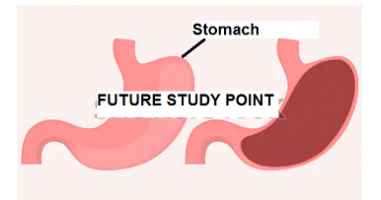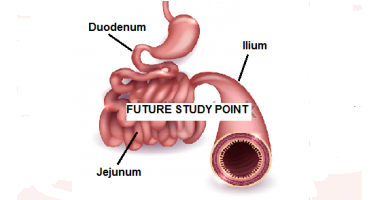Human digestive system structure and functions
The human digestive system is an alimentary canal of 8 -10 meters. The human digestive system is a hollow tube from the mouth to anus called an alimentary canal. The role of the human digestive system is digestion, absorption, and excretion through 5 main digestive organs. The human digestive system is helped by so many glands to carry on the process of digestion. Each organ of the human digestive system has its specific work in the digestion of food.

Human digestive system structure and functions
You can also study
Human reproductive systems of Male & Family
Modes of reproduction used by single organisms-Asexual reproductions
The structure and anatomy of the Heart
Anatomy of the Human brain-Class 10 CBSE
NEET Sylabus and its preparation
Human digestive system structure and functions
Human digestive system structure and functions
Humans have the 11 systems of organs, among them, the digestive system is the most significant system on the grounds that the nourishment we take is processed through it and changed over into glucose which when responds with oxygen during the respiration reaction releases vitality to all systems of the body accomplishing their specific work.
Structure and Function of Cell : Cell Biology
Human digestive system structure and functions
The human digestive system is an empty track of the length 30 feet divided into 8 parts. These parts are specialized to perform different functions. Future study point is introducing here what happens to the food once it enters our body. After you go through the whole posts of the human digestive system you could become able to answer of each question related to the digestion of food. Understanding the anatomy of the digestive system will also enable you to take care of your digestion network. In the post of the human digestive system, you will study the role of each part of the alimentary canal one by one so that you will be through with the topic.
Follow us on Pinterest
Click here to follow us on pinterest
Mouth

The food is torn, cut, and ground by the teeth, the role of teeth is to prepare food so that it could be swallowed easily because the lining on the walls of the alimentary canal is quite soft, in the mouth, the food is wetted to make its passage smooth. When we eat something our mouth waters, actually this is saliva secreted by the salivary glands. Salivary glands are located throughout the mouth. The role of salivary glands is to produce saliva which mixes with food. The food is complex in nature, it is needed to be broken down into smaller molecules so that it could be absorbed by the alimentary canal, saliva contains salivary amylase an enzyme that converts complex molecules of carbohydrate to sugar, it is the very first stage of digestion in the mouth. You can experience it by chewing a piece of bread for a long time it will start to taste the sweetness as the sugars are released.
Oesophagus

From the mouth, the food is taken to the stomach through the food pipe which is known as the oesophagus. The food moves through the alimentary canal in a regulated manner called the peristaltic movement. Peristaltic moments is contraction and dilation of circular muscles of the alimentary canal, in this moment muscle next to the swallowed food is dilated and the muscles attached to the backword of food is contracted, the peristaltic moments occur throughout the gut, in this way, food swallowed by us is not reversed back and maintains one-way traffic of food and liquids swallowed by us. The peristaltic moments occur immediately when we swallow the food.
The stomach

The stomach is a large organ that expands when food enters it, the muscular walls of the stomach help in mixing the food thoroughly with digestive juices. The stomach wall contains numerous gastric glands that secrete hydrochloric acids, pepsin, and mucus. The hydrochloric acid creates an acidic medium which facilitates the action of the enzyme pepsin. The pepsin digest the protein available in the food, protein is digested partially in the stomach. The mucus secreted by the walls of the stomach protects the inner lining of the stomach walls from the action of hydrochloric acid.
Click for online shopping
Future Study Point.Deal: Cloths, Laptops, Computers, Mobiles, Shoes etc
Small intestine
The small intestine is the longest part of the gastrointestinal tract (alimentary canal), The small intestine is about 4.75m to 6m (15 to 20 feet) long and has an average diameter of 2.5 cm (1 inch). The length of the small intestine differs in various animals depending on the food they eat. Herbivores eating grass need a longer small intestine to allow the cellulose to be digested. Meat is easier to digest, hence carnivores like tiger have a shorter small intestine. The small intestine of human is made of duodenum, jejunum, and ilium.

The duodenum connects the stomach to the small intestine, the exit of food from the stomach is regulated by a sphincter muscle which releases it in small amounts into the small intestine, most digestive enzymes enter the small intestine in the duodenum. The food rest in the stomach for about 30 to 60 minutes, the partially digested food is called chyme slowly enters the duodenum, in the duodenum, the chyme mixes with bile secreted by the liver and juices secreted by the pancreas. The fat enters the small intestine in the form of large globules, the bile secreted by the liver breakdown it into small globules. In the duodenum trypsin released by pancreas digest proteins, pancreatic amylase digest carbohydrate, and lipase digest fats.
Most Important Science Questions For Class 10 for CBSE Board 2022-23
The pancreas also secrets two hormones insulin which regulates blood sugar and glucagon which works with insulin to control blood sugar levels. The food is further digested and absorbed in the jejunum and ilium, the jejunum is the middle part of the small intestine. Most digestion and absorption of nutrients takes place in the jejunum. The ilium is the last and longest part of the small intestine. The ilium absorbs nutrients from the digested food and empties the waste into the large intestine. The walls of small intestine secrete different types of enzymes that convert carbohydrates into glucose, protein into amino acids and fats into fatty acids. The role of each enzyme is given bellow.
Maltase, sucrase, and lactase – digestion of carbohydrate
Intestinal lipase – digestion of fat (convert fat into fatty acids)
Intestinal peptidase- Digestion of protein
Large intestine

The large intestine is divided into three parts caecum, colon, and rectum. The small intestine is connected to caecum through the ileocecal valve which maintains one-way traffic of the intestinal contents. The function of the caecum is to absorb remaining water and salts available in the undigested food. The large intestine contains 500 species of different bacteria, these bacteria synthesize vitamin K which is also absorbed here. The undigested food further moves down and the rests of water is reabsorbed and thus undigested food is prepared here to be emptied into the rectum. When the body is ready for a bowl moment the waste dumped into the rectum.
Right now you can study here articles on science and maths, NCERT solutions of maths and science from class IX to XII, previous years question papers, guess papers, blog posts related to your carrier, most important questions of science and maths. Every one of our content is set up by the master educator of the subjects. You are allowed to give us any sort of suggestion with the goal that we could address you in a better way.
Important Science Notes for Class 9 and Class 10 Biology
Class 10 Important Biology Notes
What is the importance of hormones?
Male and Female Reproductive System: Complete Anatomy for Grade 10 Students
The structure and anatomy of the Heart
Human digestive system structure and function
What is the difference between the homologous and analogous structure of organs
Modes of reproduction used by single organisms-Asexual reproductions
Anatomy of the Human brain-Class 10 CBSE
Ozone Layer and How it is Getting depleted.
Food chain and food web in an ecosystem
Class 9 Biology Important Notes
Difference between Animal cell and Plant Cell
Difference between Smooth Endoplasmic Reticulum and Rough Endoplasmic Reticulum
Function and structure of Mitochondria
Class 9 Science Chapterwise NCERT Solutions and Important notes of Science
Structure and Function of Cell : Cell Biology
What are Chromosomes, DNA and Genes?
Types of plant tissues : Class 9 CBSE Notes
Animal Tissues : Class 9 Science CBSE
What is the green house effect?
NCERT Solutions of Science and Maths for Class 9,10,11 and 12
NCERT Solutions for class 9 maths
NCERT Solutions for class 9 science
NCERT Solutions for class 10 maths
CBSE Class 10-Question paper of maths 2021 with solutions
CBSE Class 10-Half yearly question paper of maths 2020 with solutions
CBSE Class 10 -Question paper of maths 2020 with solutions
CBSE Class 10-Question paper of maths 2019 with solutions
NCERT Solutions for Class 10 Science
NCERT Solutions for class 11 maths
| Chapter 1-Sets | Chapter 9-Sequences and Series |
| Chapter 2- Relations and functions | Chapter 10- Straight Lines |
| Chapter 3- Trigonometry | Chapter 11-Conic Sections |
| Chapter 4-Principle of mathematical induction | Chapter 12-Introduction to three Dimensional Geometry |
| Chapter 5-Complex numbers | Chapter 13- Limits and Derivatives |
| Chapter 6- Linear Inequalities | Chapter 14-Mathematical Reasoning |
| Chapter 7- Permutations and Combinations | Chapter 15- Statistics |
| Chapter 8- Binomial Theorem | Chapter 16- Probability |
CBSE Class 11-Question paper of maths 2015
CBSE Class 11 – Second unit test of maths 2021 with solutions
NCERT Solutions for Class 11 Physics
chapter 3-Motion in a Straight Line
NCERT Solutions for Class 11 Chemistry
Chapter 1-Some basic concepts of chemistry
NCERT Solutions for Class 11 Biology
NCERT solutions for class 12 maths
| Chapter 1-Relations and Functions | Chapter 9-Differential Equations |
| Chapter 2-Inverse Trigonometric Functions | Chapter 10-Vector Algebra |
| Chapter 3-Matrices | Chapter 11 – Three Dimensional Geometry |
| Chapter 4-Determinants | Chapter 12-Linear Programming |
| Chapter 5- Continuity and Differentiability | Chapter 13-Probability |
| Chapter 6- Application of Derivation | CBSE Class 12- Question paper of maths 2021 with solutions |
| Chapter 7- Integrals | |
| Chapter 8-Application of Integrals |
Class 12 Solutions of Maths Latest Sample Paper Published by CBSE for 2021-22 Term 2
Class 12 Maths Important Questions-Application of Integrals
Solutions of Class 12 Maths Question Paper of Preboard -2 Exam Term-2 CBSE Board 2021-22
Solutions of class 12 maths question paper 2021 preboard exam CBSE Solution



